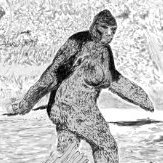Leaderboard
Popular Content
Showing content with the highest reputation on 03/29/2022 in all areas
-
This is extremely interesting. We found a tree in north Georgia that was in a small valley that had white quartz placed among its roots. Some of the quartz had been there for awhile and was mostly obscured by debris. Others had obviously been placed there recently… laying on top of the leaves and other debris. The tree had a significant feel about it, although neither one of us could really articulate why we felt that way. There is no other visible white quartz in that area and we found no other stones around the base of any other trees. We had been on that area previously, and the place was covered with X type structures. Normally, I think that 99% of tree structures are naturally occurring, but there were so many there and they were placed in paths… it was definitely odd. The image was taken with a full spectrum camera, so it has a pink/purple tint.3 points
-
I'm super new to the world of bigfoot(4 months) and I'm brand new to the forum. I would love some open minded and like minded people to discuss things with. Also, being from the UK i have a lot to learn so im looking for inspiration and guidance as I try to get to the bottom and form my own opinions on this fascinating phenomenon.2 points
-
2 points
-
PG has his own opinion. He is our lovable skeptic. Unlike a few of us, he's never seen one, so he is doubtful of their existence entirely. I can respect that position. I was in a similar place before I became a knower.2 points
-
In the movie Bigfoot's Reflection a BFF poster Bigfoothunter -Bill Miller (RIP)- makes the point of how rare it is to see normal animals in the wilderness around Lake Harrison area of Canada. He stated you can travel all day and not see a bear and so on when we know they are in the area. If Bigfoot exists, the number must be extremely small to near extinct. These numbers would be much smaller than common rare animals. I remember Grover Kranz said something like 2,500 was his guess at one time. 2 number examples come to mind: 1- One of the first wolverine sightings ever in Yellowstone National Park happen just weeks ago. It was the only one ever caught on video. The wolverine was spotted by 2 hikers. It looked at the camera crossing the road and then trotted off in a manner similar to the PGF encounter. Millions visit Yellowstone over the years and yet only one video of a wolverine sighting exists and that is just recently. 2- In Virgina a few years ago, a lost autistic child Robert Woods was lost for an entire week in the Virginia woods. It took 3,000-5,000 searchers with dogs and helicopters and special equipment 1 week to find the child in just a 3 miles search radius. The boy's condition was such he ran away from people and he does not speak. In this way, if we are looking for a real-world example of what a Bigfoot search really would entails this is the one. Running away from people and not talking made him much harder to find. Bigfoot is thought to be a quiet shy animal who also would get away from people searching for it. But, in the case of the lost boy they had 1,000's of people covering a small area with every advantage. It still took 1 week to find one person. No such search has been mounted for Bigfoot. Even if so, the area here was only a 3 mile radius. The search area for Bigfoot is just too big and the number of assumed Bigfoot are probably just too small. Unless massive drones and trail cameras are used to expand the number of eyes out there, I just doubt there will ever be a successful Bigfoot search attempt. Instead, there will only be occasional chance random encounters which might have a video thanks to cell phones. For a search to have a chance to work a person cannot just go out in the woods and start looking around. Need smoke to find the fire. First a person would have to search near high level of recent activity. If such a hot spot developed maybe hard work could pay off and one might see such a creature. Unless the camera was ready quickly, I expect such an animal would be gone in a flash.1 point
-
Perhaps they can, I'd put my money there, too. And it's not that far off from the IR spectrum, nanometrically (it's a word NOW) speaking, which I believe they can also see. But why blind myself and give them even more of an advantage over me? I'm going to give them a try and see how they work. I am glad I don't have snipers to contend with.1 point
-
One of our people made an interesting observation last summer. He would make random visits across the river to the area where we routinely hear vocals at different times. While over there, he observed a piece of rock that had a smaller sharp edge to it that had been wedged into a crack on the trunk of a tree a few feet up off the ground. Naturally, you see something like that and you just pull it out. He went back a day or two later and found the rock shoved back into the crack of the tree. IF I'm recalling correctly, he took it out again, but in the next couple of days before leaving he didn't find it put back in the tree crack. Maybe this Spring when we get settled back into camp we'll find it's been put back in. I'll contact him to have him check whenever he's back up there.1 point
-
Learned something new. Season 3 Episode 3 Dr. Mayor interviews Dr. Jane Goodall. I guess this tree structure behavior has been observed in Chimps. And she goes back to Kentucky to take more DNA samples around that tree structure. I like the follow ups!1 point
-
Exactly, Norseman. The idea is to guesstimate an 80% confidence interval. An upper ceiling of a sasquatch density equal to black bear is not reasonable or credible, but maybe that p90 is not only possible but also probable. Granted, this guesstimating only makes sense if we are talking about a real animal that has the same constraints as any other wildlife in the forest and not a portal hopping creature or ET or multi-dimensional creature, etc....1 point
-
Thanks for sharing. I am no expert but, I certainly don't believe that these are made by man apes. In fact I don't think that they are of any significance.1 point
-
Cool thread. I'm learning a lot about light pollution and how it affects us and other animals. Blue light destroys night vision (even at low levels) Moving around in a dark working environment safely requires your night vision to be on point. It takes at least 30 minutes to fully adjust to the darkness. People over the age of 70 need upwards of 40 minutes to adjust. All it takes to ruin that is a brief flash of blue rich white light. The bluer and brighter the light, the stronger the effect. The pupils immediately restrict to block out the offensive light and it will take another 30 minutes to readjust to seeing in a dark environment. You wake up in the night in your dark room. Your night vision is at peak sensitivity. Any sudden change in lighting level can ruin it. Even a small amount of blue rich light will destroy your night vision. You will also be more sensitive to the circadian disrupting effects of blue light simply because your pupils are fully dilated and will allow more of it to hit the back of your eye. Folks should adjust their screens to block as much blue light as possible. There are even apps for that. Some cover all LEDs, even if tiny. They are bad news. Just a peek at your phone when you wake up at night could impair further sleep. No wonder the big guys (big eyes) don't like lights at night. It's well known as one solution to hairy visitor problems.1 point
-
Welcome to the BFF, I'm glad you decided to officially join us and thank you for the kind words.1 point
-
If these things are undiscovered primates… who would stand a better chance of finding them? An actual primatologist who has discovered unknown primates? Or a guy who knows what color pants Roger Patterson was wearing on October 20, 1967?1 point
-
He was a good man and an excellent researcher. Prayers for his family.-1 points
-
I agree that some Sasquatches might carry pot bellies depending upon the need. Such as insulation for winter months or perhaps hibernation. But unlike gorillas and orangutans, the evidence suggests that Sasquatches are omnivores with a heavy emphasis upon meat eating. They, like humans, would not require a hind gut to aid in digestion of excess plant matter.-1 points
-
Highly unlikely that a wild animal would have insulin issues since they are physically active and eat their natural diet. Insulin resistance I’d imagine is unheard of among both wild animals and human hunter-gatherers.-1 points
-
A thought just suddenly came to me. If we had hundreds of Bigfoot researchers collecting DNA from air pumps all along forest roads this discovery could be made within a year.-1 points
-
That’s a complete and total cop out. With an attitude like that it’s no wonder the discovery hasn’t been made after half a century of research. But I suppose ignorance is bliss since it doesn’t require critical thinking in the slightest.-2 points
This leaderboard is set to New York/GMT-05:00












